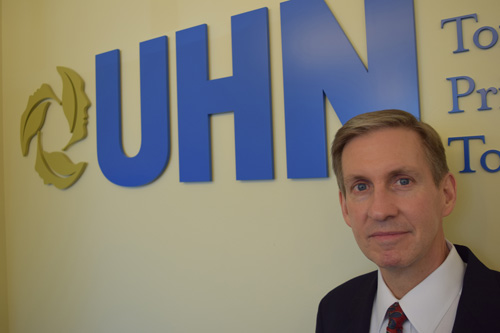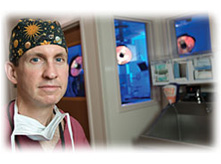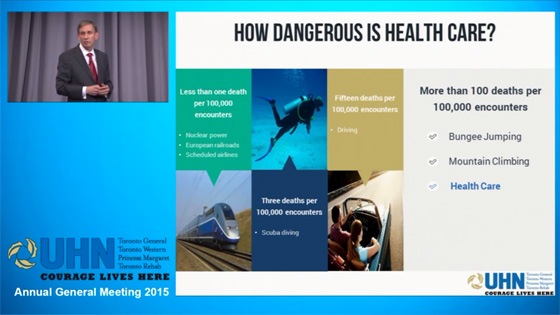
UHN President and CEO, Dr. Peter Pisters, says the sharpened focus on safety and quality is “the right thing to do for patients.” (Photo: UHN)
More than a decade on, the details remain as sharp in the mind of Dr. Peter Pisters as the day they happened, the horrible feeling of failure and frustration quickly roiling to the surface.
Dr. Pisters, then a busy clinician at the University of Texas MD Anderson Cancer Center in Houston, was leading what he describes as a very complicated operation where the patient's esophagus was removed and replaced with a transplanted segment of his colon. The surgical team was preparing to close the incision and finish its work.
But the standard instrument and sponge count was one item short. A recount yielded the right number. Two pieces of conflicting information – wanting to believe one, unable to ignore the other.
"I personally felt it was very unlikely that we had left anything inside the patient and I erred on the side of believing the second count," recalls Dr. Pisters, who became President and CEO of University Health Network in January 2015. "But there was some doubt in the back of my mind given the complexity of the case and my own understanding of how these sorts of things can happen."
To address that conflicting information, Dr. Pisters had the patient sewed up and sent to the recovery room. But he also ordered an X-ray, "fairly secure that it would be normal and validate my decision."
That X-ray showed something had been left inside the patient.
Further complicating the situation was the fact that Dr. Pisters couldn't identify on the X-ray what the item was.
In 20 years of surgery, there was never any training on what specific things left inside a patient looked like on a radiograph. Searching for answers, he and his surgical fellow X-rayed a half dozen different items, finally concluding it was a laparotomy sponge, an absorbent pad used in surgery.
Patient recovers uneventfully
"This took several hours," Dr. Pisters says. "During this time, I was going back and talking to the patient's wife and explaining that I had no idea what this was, I was looking hard and was going to figure it out.
"By the time we confirmed the problem, it was about 3 a.m. I was still there, feeling horrible, realizing we had made a significant error."
At 7 a.m., the patient was back in the operating room for a 20-minute procedure to remove the sponge.
"The patient recovered uneventfully and left the hospital seven days later," Dr. Pisters says.
"I personally never got over that. And, I learned a lot from that."
A thought-provoking video by UHN calls for a national discussion on medical errors and preventable harm with an eye to their elimination. (Video: UHNToronto YouTube)
Dr. Pisters says one of the biggest lessons for him was that preventable harm "is usually a result of complex systems where multiple points of failure or deviance from normal align to create harm in a specific patient."
In this case, several things had occurred all in the same patient at the same time – Dr. Pisters left a sponge inside the patient; one of the counts was incorrectly correct; there was no standard protocol to deal with conflicting counts; there was no system that flagged this type of surgery as a high-risk case for retained foreign body and no deployment of intensified surveillance.
"Thus, what appears on the surface to be a single error leading to harm, is in fact a series of system errors and defects that requires an entire team to understand and learn from together," he says.
Challenge to entire organization
The memory of that mistake – and countless others made daily in hospitals across North America – is at the heart of the challenge Dr. Pisters issued to the entire UHN organization at the Annual General Meeting in June: to focus on the goal of minimizing and eliminating preventable harm.
Preventable harm occurs all too often in health care and can be mitigated or eliminated by cultural change and consistent application of proven safety standards and practices.
"This is the right thing to do for patients," Dr. Pisters says of UHN's
Patient Safety Transformation Plan .
.

Dr. Pisters, seen here in his days at the University of Texas MD Anderson Cancer Center, says he’s learned preventable harm is usually the result of multiple points of failure rather than one specific incident or individual. (Source: MD Anderson)
A commitment to patients, employee and workplace safety is at the core of this transformation, but it's also about much more. In collaboration with surrounding hospitals – SickKids, Women's College and Sinai Health System – the focus is on four areas of safety and quality improvement with the goal of eliminating preventable harm and reducing the frequency of serious safety events.
The four areas are:
- Fostering a positive safety culture among staff, volunteers and patients;
- Reducing the occurrence of specific, preventable hospital acquired conditions responsible for a disproportionate amount of preventable patient harm;
- Decreasing the frequency of serious safety events ;
- Reducing preventable injuries in employees and creating a safer work environment for all.
It is ambitious. It is complex. It is a long-term vision for UHN and the Canadian healthcare system.
"We have to be constantly reminding people of the fact that this is a journey, that this will take us years to engineer over time," Dr. Pisters says. "Our work today involves the process of getting the flywheel turning."
"As you get the flywheel turning, gradually it becomes easier and easier. But you also see at times sparks flying off the flywheel and you've got to be able to anticipate those and manage those over time.
"We know that two of the most important factors in the success of transformations are engagement of the Board (of trustees at UHN) and having the CEO out front. We can count on both of those."
Raising awareness of the problem
In telling a personal story of medical error to
UHN News, Dr. Pisters is unofficially launching the first phase of the safety and quality transformation.
Today, to coincide with Canadian Patient Safety Week, a survey entitled
Speak up for Safety has been launched to take the pulse of UHN employees on how safe they feel at work and whether they are comfortable in speaking out or acting if they see something that might endanger a patient or colleague.
Daily safety huddles have recently begun at each of UHN's four hospitals for staff across clinical and non-clinical departments to discuss safety issues and develop ways to address them promptly.
Elsewhere, across UHN, a number of groups are studying different aspects of the safety and quality transformation as experienced in other jurisdictions, typically the United States, to help develop standards, protocols, education programs and other components to be rolled out in the months and years ahead.
But in the short-term, Dr. Pisters says, the goal is to raise awareness of the problem at UHN.
"In environments where incredible clinical miracles occur, like UHN, it's really possible for individuals to develop a sense of overly-rigorous self-confidence, a sense of invincibility and sometimes arrogance or hubris," he says, noting that despite all the great things done here, preventable harm happens daily.
"At this point, what we want to do is create a sense of collective concern and collective discomfort with the status quo," Dr. Pisters adds. "We did that here soon after I arrived (at UHN) by looking at our quality and safety outcomes through the lens of never events (incidents that result in serious patient harm or death that could have been prevented by organizational checks and balances) and…we could see that we had significant gaps that needed to be closed."

In his
presentation to the UHN Annual General Meeting in June, Dr. Pisters offered some sobering statistics, including the revelation that healthcare safety is on par with bungee jumping and mountain climbing. (Video: UHNToronto YouTube)
At the core of the UHN transformation are the principles of
High Reliability Organizations , which are those in such industries as aviation and nuclear power that have succeeded in preventing accidents in their typically risky and complex environments by designing their systems to avoid known sources of failure. Employees in these companies know, however, that mistakes will happen, so they are also constantly on the lookout for potential risk and feel empowered to respond in timely fashion when they see it.
, which are those in such industries as aviation and nuclear power that have succeeded in preventing accidents in their typically risky and complex environments by designing their systems to avoid known sources of failure. Employees in these companies know, however, that mistakes will happen, so they are also constantly on the lookout for potential risk and feel empowered to respond in timely fashion when they see it.
Dr. Pisters acknowledges that one of the keys to success of this organizational transformation at UHN is breaking down the hierarchical structure endemic in healthcare. It's born, he believes, out of having groups of highly-trained and independently licensed professionals "who are largely educated in silos" and have limited exposure to the concepts of teamwork and the principles of collegial communication.
"And, out of that, we've created as an unintended consequence, a caste system where there are accepted and socialized ways of communication between different castes," Dr. Pisters says. "That all needs to be broken down and we need to think about ourselves as one team united around the patient.
Culture change
"We need to create an environment around us where we encourage team members to speak up, where everyone feels completely free to articulate their concerns about the welfare of the patient."
"Engineering that change really is a critical part of what we need to do."
Dr. Pisters says that at UHN "the fundamental change is in culture" but is quick to add "we've already got so many of the building blocks in place." They include the Board of Trustees' longstanding commitment to improvements around quality and safety, the Respect & Civility @ Work Campaign, Partners in Care, inter-professional education and practice and Ignite, a consulting arm of UHN helping organizations improve patient safety.
"We've got all these great pieces but they require assembly" Dr. Pisters says. "And, once we have them assembled underneath a single brand, people will see this as not just another initiative, but as a pulling together of many different initiatives to transform the organization so that safety becomes a core value.
"At UHN, we pride ourselves in excellence in everything we do. I am so confident that we will see and embrace this incredible challenge that will save thousands of lives."
